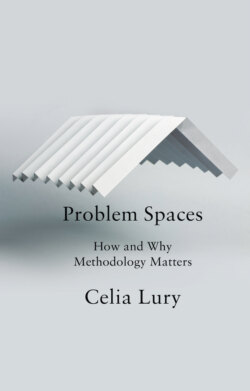Читать книгу Problem Spaces - Celia Lury - Страница 10
The structure of the book
ОглавлениеAs indicated above, the book aims to address the shifting relationships between knowledge, ignorance and power by developing the concept of problem space. It does this by exploring the inter-relationship of problem spaces and the contemporary epistemic infrastructure in which the composition of problem spaces takes place. To explicate the significance of this inter-relationship, the book is divided into: this Introduction, three Parts, and a Conclusion. Each of the Parts starts from a different point of view on the inter-relationship between problem space and infrastructure, allowing for a shifting – parallax – analysis of the possibilities afforded to a compositional methodology today. Such a structure, while complicated, is necessary since as Martin Savransky so nicely puts it:
… problems have an existence of their own, a mode of existence that is never just immanent to thought, but to a historical – which is to say, processual – world; as such, they can never be reduced to a matter of human psychology, epistemology, or methodology. Problems, in other words, are not that which a certain mode of thinking or knowing encounters as an obstacle to be overcome, but that which sets thinking, knowing and feeling into motion. (2018: 215)
The first Part has only one chapter. It introduces the heuristic of problem spaces through a discussion of five rather disparate writers – John Dewey, Herbert Simon, Donna Haraway, François Jullien and Arjun Appadurai. The aim is to situate compositional methodology, understood as the inter-linking of the formation and transformation of a problem across a problem space, in relation to established methodological approaches.
The second Part has three chapters (Chapters 2, 3 and 4). Chapter 2 describes some of the most significant changes in the contemporary epistemic infrastructure and the new possibilities they afford for configuring problem spaces. Chapter 3, co-authored with Ana Gross, considers some of the ways in which variation in price is measured, including the Consumer Price Index. This discussion of methods in practice highlight the methodological possibilities of some of the changes described in the previous chapter. This chapter also introduces the idea that these changes are being accelerated by a process of platformization, and begins to describe the implications of this process for the composition of problem spaces. Chapter 4 further develops the idea that we are witnessing the platformization of the epistemic infrastructure through a detailed discussion of the four understandings of platform identified by Tarleton Gillespie (2010): architectural, political, computational and figurative.
Focusing on compositional methodology, the third Part comprises two chapters (Chapters 5 and 6). Chapter 5 introduces some of the challenges – what I describe as the double troubles – associated with the methodological possibilities stemming from platformization including: the natively artificial character of the empirical; the multiplicity of the epistemological object; and the genus of cognitive syndromes that, following Gregory Bateson (1972), are described as transcontextualism. Chapter 6 situates compositional methodology in relation to the account of Mode 2 knowledge production developed by Helga Nowotny, Michael Scott and Michael Gibbons and others (Gibbons et al. 1994; Nowotny et al. 2001), noting shared concerns as well as differences in emphasis by drawing on the concept of the interface. This concept is deployed to develop the argument that contemporary science is neither external nor internal to society, adding to the analysis of the topological characteristics of today’s problem spaces. As part of a consideration of the accountability and autonomy of knowledge production, it also paves the way for the proposal that methods are being operationalized as part of a cultural imaginary of know-ability, and highlights the dangers of the gamification and weaponization of methods. The chapter contrasts know-ability and answer-ability and ends by outlining an ethics for a compositional methodology in terms of care, and the values of response-ability.
The Conclusion looks back at and reflects on the book’s account of contemporary topologies of knowledge and power.
